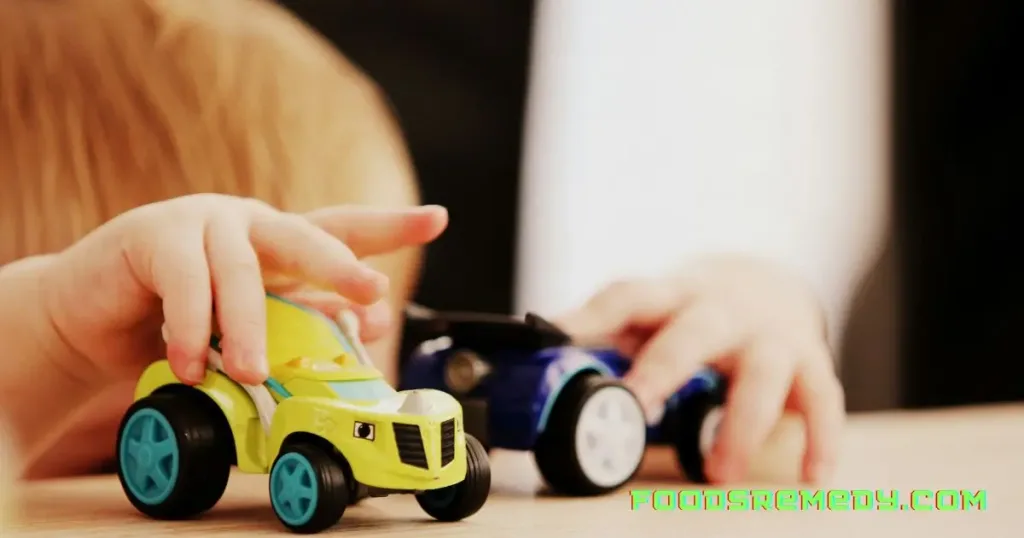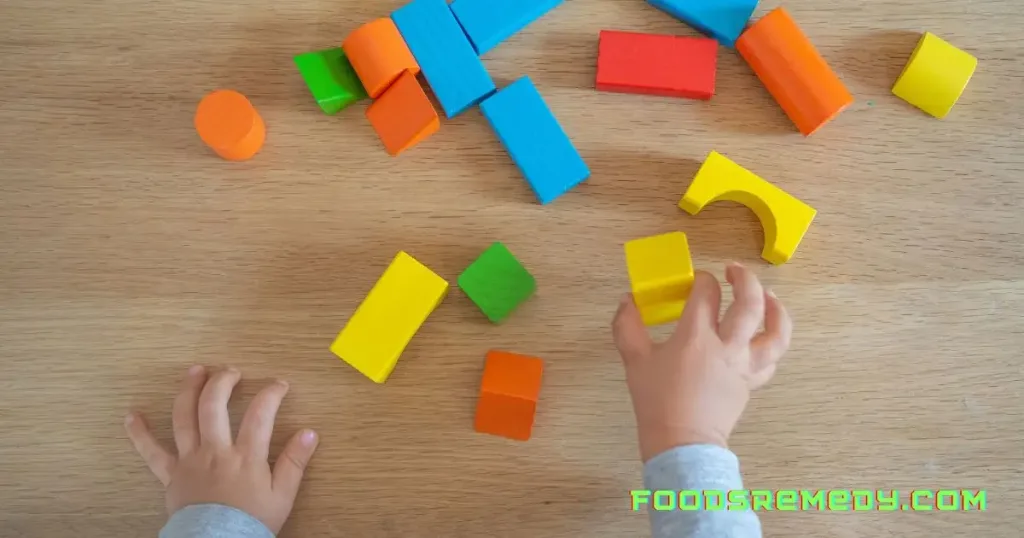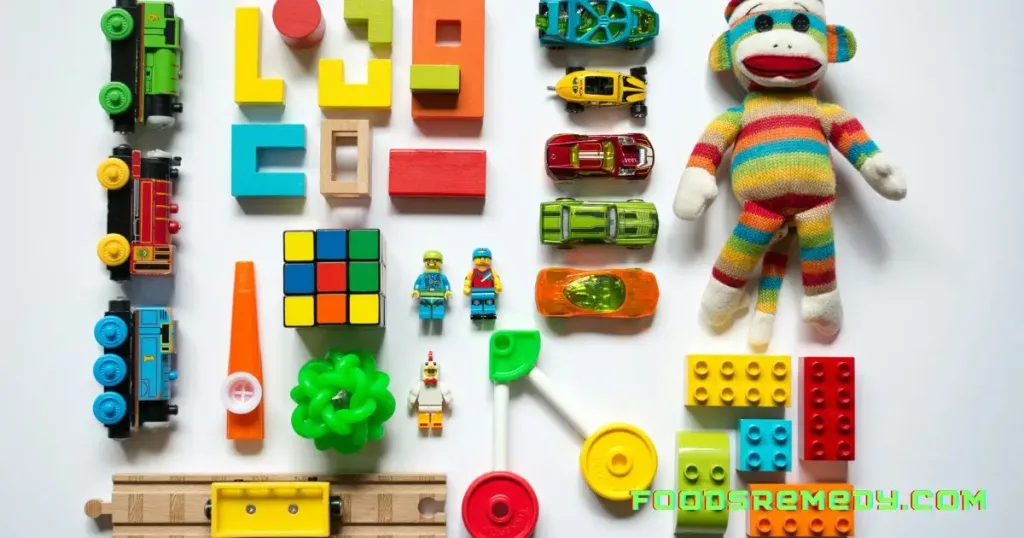Toys play a significant role in shaping a child’s development by enhancing their cognitive, social, and physical abilities. Child development is profoundly influenced by the toys they interact with, as these objects stimulate various aspects of their growth.
The cognitive development of a child is nurtured as they engage with toys that promote problem-solving skills, memory retention, and language development. Moreover, social skills are honed through interactive toys, allowing children to learn cooperation, communication, and empathy. Physical development is also encouraged through toys that support fine motor skills, balance, coordination, and spatial awareness.
Thus, toys are instrumental in fostering holistic development in children, making it vital to provide them with age-appropriate, stimulating playthings.

Credit: www.amazon.com
The Importance Of Play
Cognitive Development
Play impacts cognitive growth by enhancing problem-solving skills and critical thinking.
Social Skills Enhancement
Children develop empathy and communication skills through playtime interactions.
Types Of Toys
Educational Toys
Educational toys engage children’s minds while teaching new skills in a fun way. They stimulate learning.
Role-playing Toys
Role-playing toys encourage imagination and creativity. Kids learn social skills and problem-solving.
Toys And Cognitive Development
Toys play a crucial role in a child’s cognitive development, fostering curiosity, problem-solving skills, and imagination. Different types of toys engage children’s senses and stimulate their thinking, enhancing their overall cognitive abilities.
Problem-solving Skills
Toys play a crucial role in the cognitive development of children. One of the areas where toys have a significant impact is on problem-solving skills.
Problem-solving is an essential skill that children need to develop from a young age to navigate various challenges they encounter. Toys that encourage problem-solving can help children develop critical thinking, logical reasoning, and decision-making abilities.
For instance, puzzles and construction sets provide opportunities for children to analyze, strategize, and solve problems. As they fit puzzle pieces or build structures, children learn to think logically, identify patterns, and overcome obstacles. These activities stimulate their brain, enhance concentration, and improve their problem-solving abilities.
In addition to traditional puzzles and construction sets, there are also interactive toys available that present children with problems to solve. These toys often require children to use their problem-solving skills to complete tasks or achieve specific objectives. They can be in the form of brainteasers, board games, or even electronic toys that require logical thinking.
By engaging in play with these toys, children exercise their minds and develop problem-solving skills that they can apply in various aspects of life. Whether it’s tackling a complex math problem, resolving conflicts with peers, or finding creative solutions to challenges, the problem-solving skills acquired through toy play can prove invaluable in their development.
Creativity Enhancement
Another cognitive aspect that toys impact is a child’s creativity. Creative thinking is a skill that allows children to generate ideas, visualize possibilities, and express themselves in unique ways. Toys that foster creativity can help children unlock their imagination and explore their artistic abilities.
Art supplies, such as crayons, markers, and paint, are popular choices for encouraging creativity in children. Through drawing, coloring, and painting, children express their thoughts, emotions, and ideas. The process of creating art stimulates their imagination, boosts their confidence, and allows for self-expression.
Building blocks and construction toys also play a significant role in enhancing creativity. These toys encourage children to design and create structures using their imagination and spatial skills. They can construct buildings, vehicles, or even imaginary worlds, giving shape to their ideas and exploring different possibilities.
Furthermore, pretend play toys, such as dress-up clothes, dollhouses, or action figures, provide opportunities for children to engage in imaginative play. By role-playing, they explore different scenarios, invent stories, and develop their storytelling skills. Pretend play stimulates their creativity, fosters their social skills, and allows them to think outside the box.
In a world where innovation and creativity are highly valued, cultivating creativity in children through toy play can set them up for success in various aspects of life. Being able to think creatively allows children to come up with innovative solutions, adapt to new situations, and approach challenges with originality and resourcefulness.

Credit: www.himama.com
Toys And Social Skills
The role of toys in a child’s development stretches beyond providing entertainment. It significantly impacts social skills development in children, shaping their ability to communicate, show empathy, and build meaningful relationships. By understanding the influence of toys on social skills, parents and caregivers can make informed choices that support and enhance a child’s social development.
Communication Skills
Toys play a crucial role in nurturing a child’s communication skills through interactive play. Toys such as building blocks, puzzles, and games that encourage verbal interaction and collaboration with peers can help children develop their vocabulary and expressive language skills. Role-playing toys, like dollhouses or action figures, promote imaginative conversations and negotiation, fostering essential communication capabilities in children.
Empathy Building
Toys with emphasis on empathy building contribute greatly to a child’s ability to understand and resonate with the feelings of others. Dolls and stuffed animals, for example, allow children to role-play scenarios, practicing expressions of care and concern. Through storytelling with these toys, children learn to recognize and respond to various emotions, effectively nurturing their empathetic capacities.
Gender Stereotyping In Toys
Toys play a crucial role in shaping children’s development, with gender stereotypes often influencing their choices. This can impact cognitive and social skills, perpetuating traditional roles and limiting individuality. Encouraging diverse toy options can promote creativity and inclusivity from an early age.
Gender Stereotyping in Toys
Gender stereotypes in toys can significantly influence a child’s development. Young minds are impressionable, and the toys they play with can shape their understanding of gender roles and expectations.
Impact on Child Development
1. Gender-specific toys can limit a child’s creativity and imagination.
2. Children may feel pressured to conform to traditional gender norms.
3. Boys and girls may miss out on valuable learning experiences by sticking to “gender-appropriate” toys.
4. Gender stereotypes in toys may contribute to unequal opportunities and perceptions of what boys and girls can achieve.
Encouraging Gender-Neutral Choices
1. Provide children with a diverse selection of toys to choose from.
2. Encourage them to play with toys based on their interests rather than stereotypical gender norms.
3. Educate parents and caregivers on the importance of offering gender-neutral options.
4. Emphasize the value of open-ended toys that promote creativity and critical thinking.
By promoting gender-neutral choices in toys, we can support children in developing a more inclusive and diverse understanding of themselves and others.
Toys And Physical Development
When it comes to childhood development, toys play a crucial role in shaping various aspects of a child’s growth. Not only do they provide entertainment and enjoyment, but toys also significantly impact a child’s physical development. The use of different toys can stimulate fine and gross motor skills, ultimately influencing a child’s overall physical capabilities.
Fine Motor Skills
Toys greatly contribute to the development of fine motor skills in children. Through activities that require precise hand-eye coordination and dexterity, such as building blocks, puzzles, and arts and crafts, children can improve their small muscle control. This skill set is essential for tasks like writing, holding utensils, and fastening buttons, paving the way for independence and everyday functionality.
Gross Motor Skills
Engaging with toys that encourage physical movement, such as balls, bicycles, and climbing structures, aids in the development of gross motor skills. These activities promote balance, coordination, and strength, fostering the growth of large muscle groups. As children navigate through different physical challenges presented by their toys, they enhance their ability to run, jump, climb, and participate in various sports and recreational activities.
The Role Of Parents In Toy Selection
When it comes to child development, the role of parents in toy selection is crucial. The toys children play with can have a significant impact on their cognitive, emotional, and physical development. Therefore, parents play a pivotal role in ensuring the selection of toys that are not only age-appropriate but also provide educational value.
Choosing Age-appropriate Toys
Parents should prioritize choosing toys that are suitable for their child’s age and developmental stage. Toys that are too advanced may frustrate a child, while those that are too simple may not stimulate their growth. Selecting toys that align with a child’s age ensures that they are both challenged and engaged, supporting their overall development.
Incorporating Educational Value
When selecting toys for their children, parents should consider the educational value of each toy. Toys that promote learning, such as puzzles, building blocks, and educational games, can enhance cognitive skills, problem-solving abilities, and creativity. By incorporating educational value into toy selection, parents can actively contribute to their child’s learning and development.

Credit: raisingchildren.net.au
Balancing Screen Time And Playtime
In today’s digital age, technology has become an integral part of our lives. With the increasing availability of screens such as smartphones, tablets, and televisions, it is crucial to strike a balance between screen time and playtime for children. Limiting screen exposure, promoting active play, and finding the right balance is essential for a child’s overall development.
Limiting Screen Exposure
Excessive screen time can have detrimental effects on a child’s development. It is important to set limits and ensure that children do not spend excessive time in front of screens. According to experts, children between the ages of 2 to 5 should have no more than one hour of screen time per day.
Here are some tips to limit screen exposure:
- Establish screen-free zones in your home, such as bedrooms and mealtimes.
- Encourage outdoor activities and physical play to divert their attention from screens.
- Be a role model and limit your own screen time when children are around.
- Engage children in other activities such as reading, art, or playing with toys.
Promoting Active Play
Active play is crucial for a child’s physical, cognitive, and social development. It helps them develop essential skills, such as coordination, problem-solving, and social interaction. Here are some ways to promote active play:
- Provide a variety of toys that encourage physical activity, such as balls, bicycles, or jump ropes.
- Set up a safe and stimulating play environment that encourages movement and exploration.
- Organize playdates or join sports activities to encourage social interaction and teamwork.
- Limit sedentary activities and encourage children to engage in active play instead.
By promoting active play, you can ensure that your child has a healthy balance between physical activity and screen time.
Frequently Asked Questions Of How Toys Affect Child Development
How Do Toys Impact A Child’s Development?
Toys play a crucial role in stimulating a child’s cognitive, physical, and social skills. Different toys encourage various developmental areas, such as problem-solving, creativity, and fine motor skills. They also contribute to language development and emotional regulation.
What Types Of Toys Are Best For Child Development?
Toys that encourage active play, imagination, and creativity are essential for child development. Examples include building blocks, puzzles, art supplies, and pretend play toys. These toys promote problem-solving skills, spatial awareness, and emotional expression.
At What Age Should Children Start Playing With Educational Toys?
Children can benefit from educational toys as early as infancy. Simple items like rattles and soft toys help develop sensory skills, while as they grow, toys that promote learning letters, numbers, and shapes become beneficial for cognitive development.
How Can Parents Choose Age-appropriate Toys For Their Children?
Parents should consider their child’s developmental stage and interests when selecting toys. Look for toys that match their current skills and abilities, promoting growth without frustration. Always prioritize safety and durability when purchasing toys for your child.
Conclusion
Toys play a crucial role in a child’s development. Each toy has its own unique way of stimulating different aspects of a child’s growth – be it physical, cognitive, emotional, or social. By providing opportunities for imaginative play, problem-solving, and creativity, toys aid in enhancing a child’s learning abilities.
As parents, understanding the impact toys have on child development can help us make more informed decisions when choosing toys for our children. So, next time you’re in a toy store, consider the developmental benefits the toys offer before making a purchase.
It’s a simple yet effective way to support your child’s growth and learning journey.

